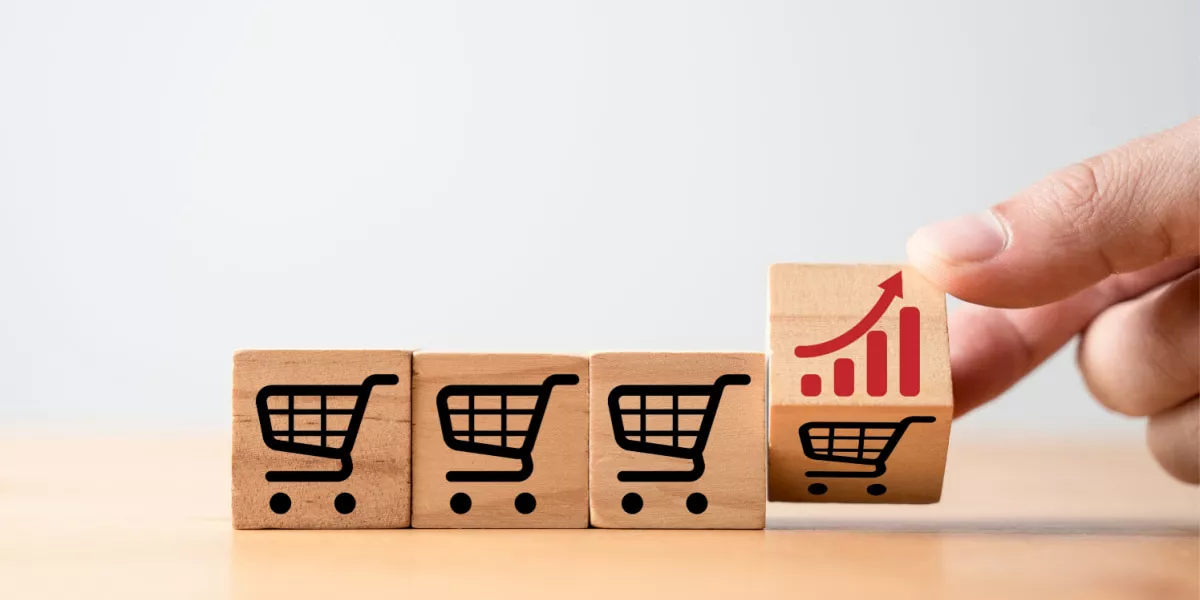Online shopping trends your business needs to be across

It's been an action-packed few years for eCommerce in Australia and there's little reason to believe the pace of change will let up much in 2024. Consumers who were once hesitant have now embraced online shopping for everything from daily essentials to big-ticket items.
This evolving landscape presents both opportunities and challenges for businesses. Those who adapt their strategies and operations around emerging trends will be well-positioned for success, while others risk falling behind.
In this blog, we'll unpack the current state of eCommerce as well as nine key trends that'll shape these digital marketplaces in 2024 and beyond. We'll also take a deep dive into the latest online shopping statistics from Australia and explain how eCommerce businesses can boost profits by staying abreast of rapidly shifting trends.
What's the current state of online shopping in Australia?
The Australian eCommerce market has experienced significant growth, driven by the increasing use of mobile devices and changing consumer behaviours. According to Australia Post, which collects a galaxy of statistics on the subject, Aussies haven't increased or decreased their online shopping activities recently - reporting only a 0.5% year-on-year growth in Q1 of 2023 when compared to the previous quarter.
Despite spending being relatively flat, the number of online shoppers is growing. Australia Post's quarterly eCommerce report notes, "There were 4.3% more households that shopped online in the quarter compared to Q1 [of the last financial year]". On average, 5.7 million Australian households shopped online at least once a month during the first quarter of this financial year.
Presumably due to cost-of-living pressures, there have been changes in what Australians buy online and where they buy it from. Consumers are shopping more at online marketplaces and spending a lot more on 'beauty' and 'athleisure', and a bit more on 'auto parts'.
The quarterly report by Australia Post also found that consumer confidence remains low, although there was a slight uptick in August and September. This may indicate the worst of the post-pandemic hangover is over.
Statistica data shows the 'Big Five' online retailers or marketplaces in 2023 were Amazon, Kmart, eBay, Woolworths and Coles. Other heavy hitters include Big W, Chemist Warehouse, JB Hi-Fi, Target, Bunnings, Officeworks, Myer, Facebook Marketplace and Catch of the Day.
What do Australians mostly buy online?
The data indicates a phenomenon known as the 'lipstick effect' where individuals are postponing major purchases and finding solace in smaller ones. Specifically, women tend to gravitate towards beauty products and athleisurewear, while men lean towards car parts.
But judging by recent Statistica data, it seems that Australians have continued buying in 2023 what they've long bought online: clothes; shoes; food and beverages; books, movies, music and games; cosmetics and body care; pharmaceutical and health products; bags and accessories; and consumer electronics.
Australians are being more strategic about all their purchases and are sometimes swapping smaller, feel-good 'treat' purchases for larger ones. But the kind of goods they are buying online hasn't changed much.
9 trends that'll shape the eCommerce landscape in 2024 and beyond
If spending is flat and Australians are, more or less, buying the same things online they always have, what are the eCommerce trends of 2024 that businesses can take advantage of? The current industry consensus seems to be that the greatest return on investment will come from using existing or emerging technologies more effectively.
Here are nine online shopping trends to focus on in 2024.
1. Video will be even more important
You may or may not consume a lot of online video content, but your consumers, especially the younger ones, probably do. So, a static image and a product description may not be enough to close the deal with many of them in 2024. Quality video content that showcases your product's design and function is a better option, where feasible.
2. The 'Metaverse Mall' might (finally) arrive
Augmented reality (AR), virtual reality (VR), mixed reality (MR), the Metaverse - whatever you want to call it, the idea of digitally road-testing a product before buying it has long appealed to consumers. Unfortunately, AR/VR tech has long remained relatively primitive and unpopular.
However, Meta and Ray-Ban collaborated and released smart glasses in late 2023. Apple is bringing out its first headset in 2024. If having a screen strapped to your face for extended periods becomes more fashionable, there will be opportunities for businesses to showcase their products in an AR/VR/MR setting.
3. Mobile first, second and third
As mobile phones have become more powerful, have you found yourself doing more on your phone and less on other devices? It's the same with your customers, with surveys now showing consumers overwhelmingly do most of their online shopping on their mobile.
4. Voice search will go to the next level
Even many who aren't digital natives are now in the habit of talking to (rather than typing into) their phones and smart home devices. In the US, Walmart has already made it possible to order any item it sells by voice. Australian consumers may soon expect to be able to do likewise, both from giant retailers and corner shops.
5. Turbocharged AI investment will have (unpredictable) consequences
The apparent capabilities of ChatGPT led to vast sums being invested in AI from late 2022 onwards. Nobody is yet quite sure how AI will impact industries such as retail. Still, there's a widespread view that increasingly sophisticated generative AI will allow retailers to do increasingly sophisticated things.
6. Social commerce will continue to grow
Social commerce might seem like old news, but it's likely to become an even bigger deal in 2024. In recent times, platforms such as TikTok have introduced shopping features. And, as always, it's sensible to set up shop where many of your existing and potential customers gather. Social commerce is a win-win-win deal for platforms, retailers and consumers, so expect shopping while scrolling to become even more frictionless and popular.
7. Businesses will need to offer a little extra
If financially stressed consumers are going to buy from your business, they will want to feel they are getting value for money and receiving something they aren't likely to get elsewhere. Maybe that's an above-average level of personalisation; perhaps it's a gift card with every purchase over a certain amount. The specific offer probably doesn't matter as much as ensuring all your customers feel valued.
8. A blurring of the lines between online and offline retail
Along with a general blurring of the boundaries between the digital and the 'real' world, the division between online and offline retail is getting fuzzier. Perhaps the most interesting example is bricks-and-mortar stores increasingly morphing into, for instance, combination cafés/stores that people spend time in even when they aren't buying what the store (mainly) sells.
If consumers spend more time in a retailer's bricks-and-mortar stores, they may later purchase what it (mainly) sells online. Obviously, 'hybrid retail' won’t be an option for all eCommerce retailers. But those etailers with physical stores or the capacity to open them may like to research what retailers in the US and UK have been doing in this space.
9. Etailers will hit MACH speed
It's always been the case that those wanting to run a profitable eCommerce business needed a robust tech stack. There isn't space to go into detail here, but the best tech stack for an eCommerce business in 2024 will likely be a 'MACH' one. So, you may want to move on from your eCommerce platform and embrace MACH (Microservices, API-first, Cloud-native and Headless) architecture this year.
How your business can tap into the latest online shopping trends
Emerging technologies always attract plenty of attention. But simply making better use of established technologies can do wonders. So, before spending up big on, for instance, a new tech stack, you may want to first check you're doing the simple things well.
Few people focus on the role discreet technologies, such as label printers, can play in driving efficiencies and significantly cutting labour costs. However, eCommerce businesses often have to print a wide range of labels and can potentially bank substantial savings by printing those labels as efficiently as possible.
An industry-leading label printer, such as Brother's QL-1110NWB, can quickly make a noticeable difference in unit costs. The QL-1110NWB can print a wide range of labels, including shipping labels, and seamlessly connects to eCommerce platforms such as Shopify and WooCommerce. It can also print from both desktop computers and mobile devices and comes bundled with Brother's free label design software - P-touch Editor.
Read our guide on how to stay ahead of eCommerce trends with cutting-edge technology
Technology to help you stand out in a crowded eCommerce landscape
While the gold-rush era of 2020-2022 is now long over, there's still plenty of money to be made from eCommerce, especially if the most effective technology is deployed.
As well as looking into the attention-grabbing technologies mentioned above, you may want to consider the potential ROI of purchasing a desktop or portable label printer capable of churning out product labels, shipping labels, barcodes and QR codes at minimal cost and with maximal efficiency.
Brother's RJ-4250WB Bundle-Pack allows you to print from wherever you are operating instead of printing from a central print station, increasing the speed and accuracy of labelling workflows, such as packing orders or sorting SKUs. Brother also offers a range of label printers and helpful apps and plugins that can help eCommerce sites thrive.
As has been the case for every year the industry has existed, eCommerce businesses in 2024 will need to engage in ongoing digital transformation or risk becoming uncompetitive.
Fortunately, there's expert guidance readily available. You can chat with one of our experts about your existing workflows and business goals. We'll be able to suggest Brother products that could lighten your workload while fattening your profit margins.

Resource Library
Be the first to receive exclusive offers and the latest news on our products and services directly in your inbox





.jpg?h=720&iar=0&w=1920&rev=36358aeeea934b07bce65a5d230d3519)

